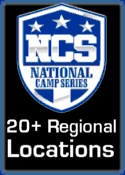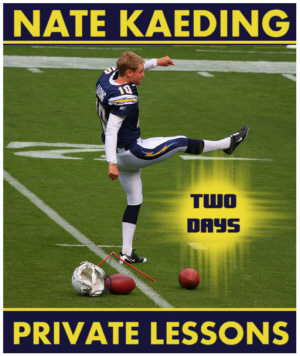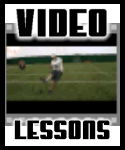|
GUEST EXPERT ARTICLE
You must set a punting and kicking training program that has an emphasis on technique development. Regardless of the level of performance your punter has accomplished, a period of technique evaluation, film evaluation and drill development is needed. Too many punters just kick for their training and that will be their down fall. The player can develop bad habits if a proper training program is not in place.
The training program I will show and explain to you is so important towards maximizing your punters ability.
Proper technique and training is the foundation for being a consistent and effective performer. Working on their fundamentals to perfect the proper technique is what needs to be developed to successfully execute the skill of punting.
The first set of photos you will see is what most punters have learned, the result of this is that you will only be an average punter not a real weapon. I will explain to you what needs to be adjusted in their technique for maximum performance.
The Stance: Feet, head and body pointing toward the direction you want to punt the ball down field. Your weight must be evenly distributed and on the balls of your feet.
Hips and shoulders square but your shoulders should be over your toes as though you are almost leaning forward. Your knees should be slightly bent (see Figure 1)
Feet: You're kicking foot in front of the plant foot slightly ahead - feet inside shoulder width. If you are to use a shuffle start your plant foot will be slightly ahead of your kicking foot. The shuffle builds more mom tem into the punt- right foot kicks back and down the plant foot jab steps 6 inches forward. (See Figure 4)
Leg alignment: The punter must line his right or left kicking leg over the center so the ball is received over the kicking leg
Receiving the ball: Every punter I have coached starts with their arms and hands straight down.
The problem with this is that you have to move your arms and hands to catch the ball to adjust ball for proper alignment to place it on your drop table (Drop table goes from your soloplex-mid chest (see figure 1 & 7). This takes time for a punter to accomplish this witch will effect his get off time, alignment and drop placement. This will also affect his reaction time if he receives a bad snap. Example: (fumbling the ball)
Punters make this motion when the ball is 3-4 yards from them (see Figure 2) and when they receive the ball they bring the ball right back down on their first step (see Figure 3). This happens because of muscle memory and lack of drill training. You already told your mind it is ok to have your arms to your side.
Just as the long snapper is to fire that ball back to you your arms must be in front of you palms facing up and fingers open showing a target for the snapper with a slight bend at the elbows-do not bring the ball into your body when you receive it. (See Figure 4)
If you have a high snap-your hands are there with a quicker reaction time then if they are by your side. If the snap is low you can scoop the ball and place it on the drop table for proper alignment.
Once you received the snap immediately turn the ball to its proper position laces up. A lot of coaches say turn the ball 5 degrees inside. Why would you do that when the ball naturally will turn 5 degrees on it's own from the force of body movement and drop. If you turn the ball 5 degrees then your ball will turn 10 degrees to the inside of your body and you will only turn over 55% of your punts or the punts will fish tail, end over end or shank. Keep the ball straight down field do not look at laces for alignment with your right eye for that will have the ball on the inside of your leg. Look at the inside logo of ball with your right eye (right legged punters) left legged use left eye. This will allow you to line the ball over the center of your leg. Tuck the elbow inside but not next your body - in front of you over the center of your kicking leg. (See Fig 5)
Proper Hand Placement of the ball:The ball must not be dropped but float to the foot for proper hitting position. Every coach teaches different ways to hold a football. A lot of coaches teach player to hold or grip he ball with the hand on top of the ball or held by the nose. The problem is that the ball when released will have a quicker descent for the drop. It also can leave your release arm still tucked into the body which will leave the ball to close to the body and will cause the punter to lean back. (See Figure 6)
Figure 7 is Freddie Capshaw - Former Miami Hurricanes Punter and Ray Guy Award Finalist. We teach to hold the ball underhand or to the side a little. Side Hold: The hand on the side of the ball with the first and second finger under the stitch line-outside of ball- side of ball and the third and fourth finger under the ball. The thumb would be on the inside of the ball and inside of body. The right eye is looking at the inside logo of ball. The back point of the ball would fit in the palm pocket and the ball is straight not turned laces up. (See Figure 7)
One of the finest punters in Miami history - exceptional punter who consistently punts for distance and accuracy. Freddie is one of the best punters I have seen and in 2003 was with San Francisco 49ers in pre-season. Any NFL team should have him in their camp-he is that good.
The Under Hand Placement: Similar hold as the side hold just that the thumb finger is on the right side next to the logo out side of body (example: Wilson , Nike etc.) The hand is at the back of the ball underneath and fingers spread the ring finger on the seem. The right eye is looking at the inside logo of ball. The back point of the ball would fit in the palm pocket and the ball is straight not turned laces up. This will allow the ball to float out then just drop quickly past impact point. The point of this is to get the ball to float out to your foot with minimal descent- almost like a trap door-punting it out of your hands. Your drop would only descent a foot to a foot - not three feet. (See Figure 8)
The Approach and drop: Your shoulders would be ahead of the hips square to point of target. The first step is a short natural walking step, do not over stride on steps or your body will pass your impact point which will cause the punter to lean back (looks like he is sitting in a chair) and the ball would be by his knee. (See Fig 6)
The second step is parallel remaining square, walking stride this will keep your body square for ball contact and leg lock and will eliminate crossovers and from over striding on the second step. (See Fig 9) You have 3-4 yards for impact point any more will result in a blocked punt, you must have a short second step not over stride to pop your hips through the ball. We call it short step and pop. First step is walking stride second is walking stride but moving quickly into the punt towards target direction. The left hand moves off the ball when you're on to your second step (see Fig 8) right elbow still slightly bent.
In Figure 9, the left arm does not go past your shoulders so you do not cause your self to lean back your body weight is going forward at a 45 degree angle. The elbow now pops the ball forward from the bent position by extending the elbow (arm) forward - not down - to cause it to float out to impact point not drop. The ball releases the hand when the second step heal is to touch the ground- you can see the sole of the cleat. As the ball leaves the hand it will float out straight and level with a slow descent. Floating up and out. Do not pull the drop arm down ward you then telling the ball to drop down at a quicker descent. Have the arm pop-elbow forward as you are giving the ball to someone and the arm moves to the right not down. You will see from (fig 9 and 11) the punter is not over striding - if he was both feet would be off the ground and the ball would be to close to his body. (See fig 10) The ball is held by it's nose and the elbow didn't extend the ball to float forward as seen in picture and the ball is to close to this punters body as the nose of the ball heads for a nose dive which will cause this punter to lean back to make contact. These causes will have you to lose 35% power. When you are air born as seen in this photo all your weight comes crashing down on the plant spot not generating the power to thrust at a 45 degree loft. You then are using your leg because your power is now behind you.
As the ball floats forward (see fig 11, 12, 13, 14) fires through the ball with a popping thrust - this is were the hip and knee are pulled through the ball. The foot meets the ball near knee height in front or just above it. As the leg hips and knee pop through the ball this is driving your body to thrust at a 45 degree angle down field with your head down and shoulders forward. From the knee down is the whip action of the leg for leg lock and ball contact would be for the nose of the ball at 11 o'clock and the back of the ball at 5 o'clock on the bone of the foot, the ball from floating out and turning on its own which will be 5 degrees a foot impact will result in the ball turning over and high booming spirals.
Figure 15 will show from the pop action hips and knee the thrust of the body launching the ball to its desired target. The Follow through: The pop back swing of the leg is parallel to the ground see (fig 11) and the thigh an hip muscles drive the leg through the ball and the "whip" is from the knee to ankle firing through the ball see (fig 12,13,14). The knee and leg swing must be straight through the ball - attack it - the leg will follow straight through and up to the right eye and right ear side of head, you will not have a cross over if all aspects of this article are followed. From the hips and knee pulling your body through the ball this will lead to the popping noise of the ball making impact to foot. Your body will drive through the ball from the "whip" action, hips and knee to leave the ground with the plant foot and the ball riding your foot for a longer period for maximum hag time. (See Fig 14,15,16,17, 18)
Your body will continue down field allowing that momentum to carry your body to point of target.
View workouts and training schedules for kickers and punters >>> Learn more about Mike McCabe >>> |

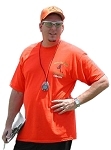 The Art of Punting - What is Needed to Coach Punting Properly
The Art of Punting - What is Needed to Coach Punting Properly





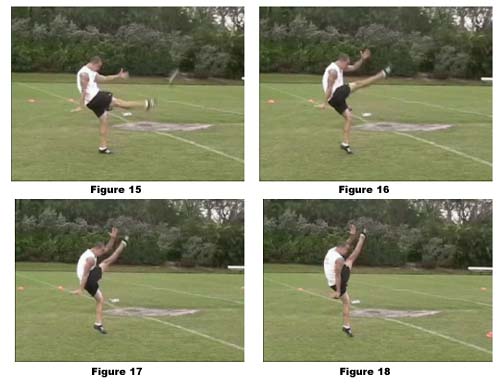
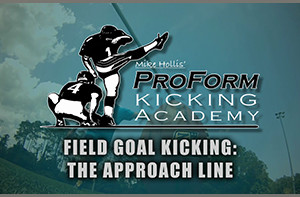

 Doug and Tommy's Frequently Asked Questions
Doug and Tommy's Frequently Asked Questions
